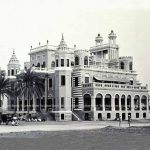World Theatre Day
All the World’s a Stage
“I regard the theatre as the greatest of all art forms, the most immediate way in which a human being can share with another the sense of what it is to be a human being.” – Oscar Wilde
The inherent purpose of art is to invoke emotion in its audience, be it painting, music, literature, or any other form of it. The emotion thus evoked can range from joy and elation to grief and bereavement. Theatre is matched by few other forms of art in the lucidity by which it communicates the message and feelings of the artists to their audience.
‘World Theatre Day’ is annually celebrated on 27th March. This was first initiated by the International Theatre Institute, which is a UNESCO associated NGO, in 1961. It was first proposed in Helsinki, then at the 9th World Congress of ITI in Vienna by the President Arvi Kivimaa on behalf of the Finnish Centre of the International Theatre Institute. It is celebrated on this specific date to coincide with the opening date of the 1962 “Theatre of Nations” season in Paris. Each year, ITI invites a luminary from the field of dramatics to share their views and ideas on theatre and hence, they relay this message across the world. It is translated into, as of 2015, 42 languages and is read to an audience of tens of thousands worldwide in various theatres across the globe and is printed in numerous publications. The individuals who have given these messages include distinguished people such as Dame Judi Dench in 2010 and John Malkovich in 2012.
One of the oldest texts to mention theatre or drama, as we know it in its present form, can be traced back to Aristotle’s classic work, ‘Poetics’ . Aristotle is also famous for being the personal tutor of Alexander the Great. In ‘Poetics’, he mentions how drama is different from the sacred mysteries (religious rituals) as it does not require the audience to fast or be part of a procession, on the other hand he talks how it, like sacred mysteries, provides purification and healing by means of a ‘theama’, a vision. Also, the place where this took place was aptly named ‘theatron’.
The word ‘Theatre’ itself is of Greek origin. Out of the thousands of plays written during 6th century BC of the Greek empire, not one survives today. Of those written during 5th century BC of ancient Greece, only 32 have survived the test of time and out of these the complete texts of only three have been found, the Aeschylus, Sophocles, and Euripides. This period laid the foundation of modern western drama and theatre. Greek, and later Roman, culture and art has had a profound effect on the modern civilization and its culture, particularly in the western world.
The history of theatre in India is also a fascinating tale in itself. The ‘Vedas’, one the oldest pieces of literature of any kind, hymns written between 15th and 10th century BC, have no mention of theatre. Thus, the major source of knowledge of ancient theatre in India is ‘Nātya Sāstra’, whose authorship is credited to Bharat Muni, written around 225 BC. ‘Koodiyattam’, based on the Sanskrit theatre traditions, is a 2,000 year old form of theatre, the most ancient in India, is recognized as a Masterpiece of the Oral and Intangible Heritage of Humanity by UNESCO. India has also produced great playwrights and dramatists whose works are considered as bona-fide classics. Kalidasa, Bhavabhuti, Aśvaghoṣa and Śūdraka are revered as greats of the field. The great emperor Harsha is attributed to have written three plays himself, Ratnavali, Priyadarsika and Nagananda.
Modern Indian theatre is vastly varied due to the broad spectrum of people who populate this country. The many different lands of India have been conquered by many different people such as the British, the Mughals, the great conqueror Ashoka, who later became a reformed Buddhist after the Battle of Kalinga, and many others. All these civilizations have left marks and indentations on the culture of this country. This has also had an effect on the modern theatre here, producing numerous forms it.
‘Nautanki’ is the form of theatre which indigenous to Uttar Pradesh. Kanpur, Lucknow and Haathras are considered the hotbeds for this form. Traditionally this form has been a male profession but in recent years women have also gained a prominent place in modern theatre companies.
‘Tamaasha’ is a traditional folk theatre which originated in Maharashtra, this kind of theatre is particularly unique as this the main exponent of movements in the play is the actress rather than the male actors.
‘Maach’, the traditional art form from Madhya Pradesh is famous for the important role songs play in this form. The word ‘Maach’ is also used for the stage where the performance of the play takes place.
The aforementioned Koodiyattam is very popular in Kerala. This form has preset character forms such as the ‘Sutradhar’ or the narrator, the ‘Naangyaar’ or those who take up the role of women and the ‘Vidhushak’ or the jester, who plays the role of the protagonist and delivers the bulk of the dialogues.
There is ‘Dashavatar’ from Konkan and Goa, ‘Bhavai’ which is the traditional form from Gujarat, ‘Bhand Panther’ of Kashmir, ‘Swang’ which is a music-based form that is prominent in Rohtak and Hathras and then there is ‘Raasleela’ which is a subset of theatre which is based solely on the legends of Lord Krishna. These are but a few kinds of theatre present in this diverse country.
The art of theatre is in many ways like wet clay. It can moulded into different shapes and forms to suit the preferences and heritage of the indigenous people. And like clay, once it sets, it becomes durable. And it is a testament to its durability that even after countless conquests over the course of thousands of years, it still survives with all its resilience. In India, it is as much a part of the identity of people as their local language. It is much more than just a form of entertainment. Shakespeare once wrote that – ‘All the world’s a stage, And all the men and women merely players’. This idea may be reason why theatre is so prominent across the globe, in countless countries and regions; due to the affinity it has to connect with the life of regular people in a very real and human way. And there must be a reason behind it to explain the omnipresence dramatics and theatre across most culture as almost all cultures have some form of it present in their society.
Thus, in one way, we can say that theatre and dramatics are an invaluable and irreplaceable part of the modern human culture and society, and the least we can do commemorate its role in shaping the present day civilization is to celebrate it on the 27th of March.
Udit Verma
(Published in The Lucknow Observer, Volume 2 Issue 24, March 2016)




